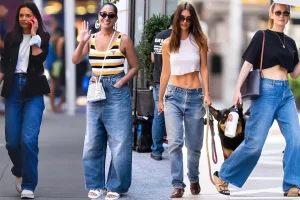From the CEOs of global conglomerates coming face to face with the people clothing waste impacts, to the air miles and carbon emissions racked up on the journey to each one, Sophie Benson weighs up whether they’re all talk or things really get done
A few weeks ago, finally up in the air after a spirit-crushing eight-hour delay, I found myself grappling with the sheer irony of what I was doing: flying to another country to listen to people talk about sustainability. It was my second time attending the Global Fashion Summit in Copenhagen and I was keen to see whether conversations had moved forwards since 2022 and whether there might be any reporting back on progress made, especially as this year’s theme was “Ambition to Action”.
Summits and conferences are standard practice for pretty much every industry going but, understandably, people question the need to fly in from around the world for events such as this, as well as bigger affairs like COP, where climate and social justice are the topics in hand.
Panel themes in Copenhagen included global policy, traceability, net zero, textile waste, resale, and regenerative agriculture. All conversations worth having, but do they get us anywhere?
As an event with both press and brand competitors in attendance, naturally some conversations were more self-congratulatory than groundbreaking. Certain brand execs took to the stage and declared their products to be sustainable with zero basis and went largely unchallenged, while others talked about the efforts they were making to ‘fix’ fashion’s problems without being taken to task over the fact they are the ones creating those problems in the first place.
“We talk about what we’re doing well, when it is OK, but we don’t talk about difficulties at the summit,” said Sophie Hersan, co-founder of Vestiaire Collective. “Yes, we all want to be exemplary… we’re proud of what we’re doing because we all work hard to be better, but we still face difficulties… and we could find a good solution. How can we help each other? How can we collaborate?”
“I felt like we were lacking some concrete examples. It’s amazing how many ways you can find to say, ‘we need to change’. We’re all here, we all know that,” said Dazed 100 designer Sarah Brunnhuber. But while a concrete roadmap didn’t necessarily emerge, some conversations at the 2023 summit did feel like they could edge towards solutions.
The Sustainable Fashion Communication Playbook, published by the UNEP and UNFCCC and authored by Rachel Arthur, launched at the summit. Aimed at everyone from fashion marketers to journalists, it seeks not only to tackle greenwashing and misinformation but completely alter the narrative around fashion, reducing the perpetuation of overconsumption and redirecting consumer aspirations.
“We talk about what we’re doing well, when it is OK, but we don’t talk about difficulties at the summit. Yes, we all want to be exemplar, and we’re proud of what we’re doing because we all work hard to be better, but we still face difficulties. How can we help each other? How can we collaborate?” – Sophie Hersan, Vestiaire Collective
I had to sit on the floor at the “Unpacking European Policy” session as it was packed out, highlighting the appetite for a more mandated approach to sustainability with set in stone, legal guidelines. A lively back and forth between the panellists was refreshing, and highlighted the tension between the snail’s pace and exclusionary nature of Western policy making and the urgency and global impact of sustainability, or a lack of it.
Cynthia “Abena” Essoun, Community Outreach Manager at The Or Foundation, attempted to relay some of that urgency and impact during her panel by handing out some of the damaged, low quality clothing that had been exported to Ghana and received at Kantamanto Market. “Ghanaian people are very discerning when it comes to fashion. If you send a shitty garment to Ghana, no one will buy it,” she said. “If nobody buys it, it becomes waste.”
The Ghana-based foundation was there to talk about its Stop Waste Colonialism campaign which calls on policy makers to implement globally accountable Extended Producer Responsibility (EPR) programs which would include measures such as a $0.50 fee per newly produced garment, the distribution of funds to the Global South to account for loss and damage, and reduction targets for new clothing of at least 40% over five years.
During a break I spoke to Kwaku Mensah, a tailor at Kantamanto Market who upcycles 100 pieces every day and works 14 hours a day six days a week. He told me that EPR funds could allow him to make his workspace safe, hire more people, expand his production, and therefore earn enough money to move beyond existing hand-to-mouth.
“Ghanaian people are very discerning when it comes to fashion. If you send a shitty garment to Ghana, no one will buy it. If nobody buys it, it becomes waste” – Cynthia ‘Abena’ Essoun, The Or Foundation
Creating a meeting point between – to put it bluntly – the perpetrators of fashion’s evils and the ones on the receiving end of them is a vital function of summits like this. Brand executives should be faced with the waste their brands create, and they must meet people at the other end of the supply chain. “The connections are important,” says Josephine Philips, founder and CEO of repair platform SOJO. “Sometimes you need to be reminded of emotion or people’s lives being affected by what you’re building. Touching the clothing that has come from the beaches in Ghana, that could only happen in person.”
Input from the likes of The Or Foundation, climate non-profit Stand.Earth, and the brilliant members of the Next Gen Assembly was among the most radical, but it felt overshadowed by the time given over to major brands, global corporations, and sponsors.
“I feel like there’s really no grace or space for foundations and nonprofits – the ones that are on the frontlines of these spaces – and we’re still not acknowledging that the production of clothing is literally killing people,” said Isaias Hernandez, aka Queer Brown Vegan, who was attending for the first time. “That, to me, makes it feel like we’re [at] a dystopian summit where there’s people who are worried about the future of a diamond ring, and there are people who are scared if they’re going to make it to the next day or have enough money to support their garment workers.”
The dichotomy at play was tangible and many attendees noted feeling conflicted or just flat out “weird” about the whole thing. But that’s not to say this summit, and others like it, aren’t considered to be useful for progress and connection.
“Creating a meeting point between – to put it bluntly – the perpetrators of fashion’s evils and the ones on the receiving end of them is a vital function of summits like this. Brand executives should be faced with the waste their brands create, and they must meet people at the other end of the supply chain”
“I find it a promising sign that industry leaders spent this much time together focused on the issue of sustainability. I was also happy to note that some industry actors, albeit still a minority of voices, were pushing for a strategic rethink and whole-industry approach rather than the peripheral changes that tend to be observed at individual-business level,” said Dr. Lewis Akenji, Managing Director of the Hot or Cool Institute. Brunnhuber, who was attending for the first time, added that she appreciated the presence of critical voices and the access to breakdowns on complicated topics like policy.
Perhaps an unknown element of the summit is the meetings that happen behind closed doors throughout. “Alongside the on-stage content, at the Summit we hosted over ten private, closed-door roundtable meetings with key stakeholders addressing a topic via intimate discussions which have been carefully curated by GFA. Participants included policymakers, brands, NGOs, and more and allowed those involved to candidly discuss challenges, learnings, and opportunities towards meaningful progress,” said Federica Marchionni, CEO of Global Fashion Agenda, which has also tackled the people-flying-from-all-over-the-world problem by offering online access to the summit for a significantly reduced price.
Given the disparate, global nature of the industry, a central meeting point is necessary but within that setting, problematic brands can and do continue to obfuscate and delay. “Over 70 per cent of environmental impacts of fashion are caused at the pre-use phase, with most of the consequences being felt in developing countries. Yet the fashion industry is either engaged in burden-shifting, placing the negative consequences of its actions on poor countries where manufacturing takes place, or it practises consumer scapegoatism, putting the blame on consumers to shop green,” says Akenji. “I hope future summits reflect this need for urgency, and that they end in concrete commitments towards reducing production volumes and more socially just practices, rather than window dressing and greenwashing.”
From a personal perspective, being in one location with other journalists, activists and organisations trying to press the industry forwards is energising, but tinged with the ever-present anxiety that it just won’t amount to enough. SOJO’s Philips sums it up best. “It feels like the energy is here… This many people want to change, this many people are saying they want the changes. Will that actually materialise? I suppose what I’m taking away is excitement, cynicism, and hope,” she says.
Source : DAZED




























